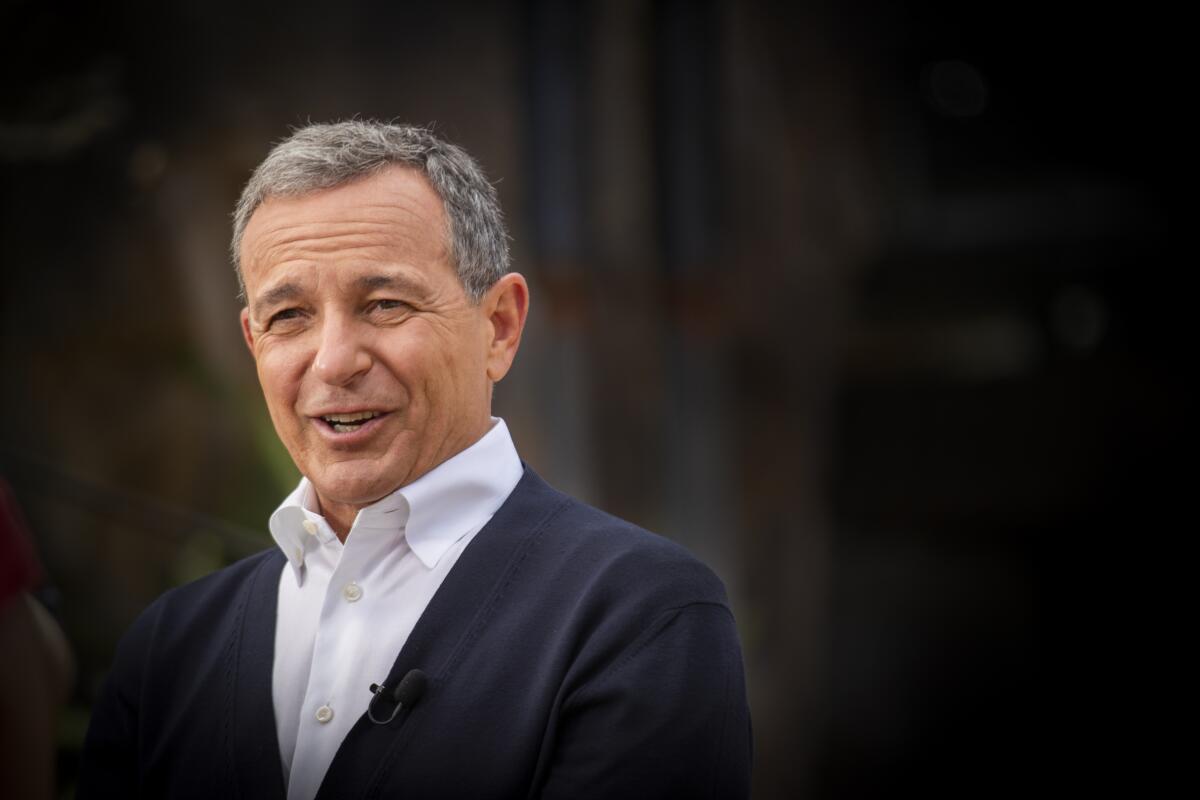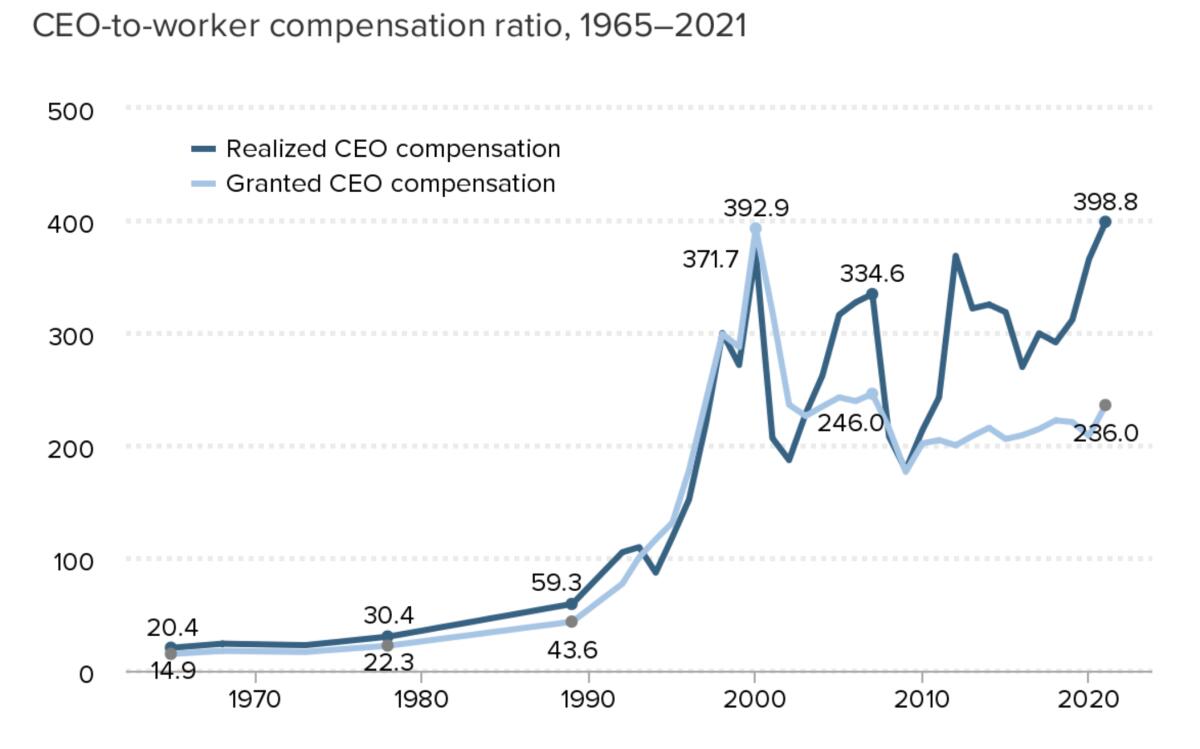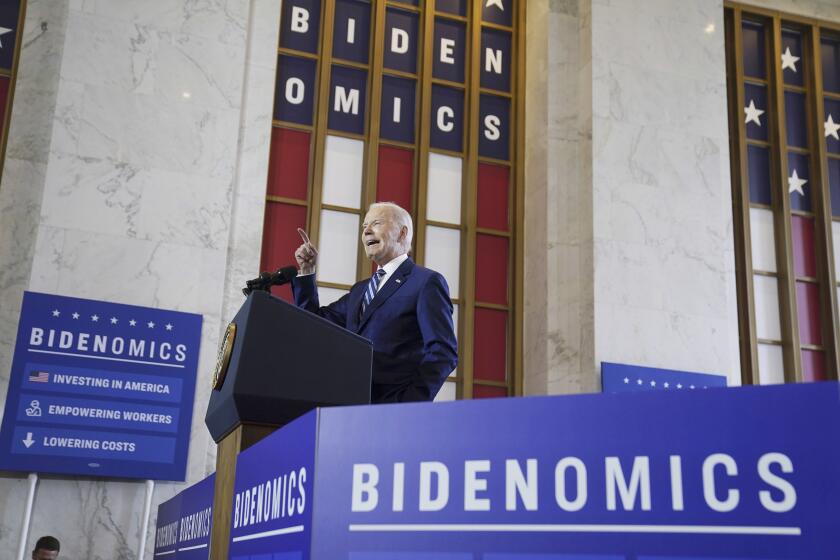Column: By the standards of their peers, Hollywood CEOs aren’t all that overpaid. That’s the problem

- Share via
The writers and actors union currently on strike in Hollywood have made a big issue out of the extravagant pay packages enjoyed by the studio heads they’re fighting.
“If they don’t have any money to give us raises, then how did they — the executives in the C-suite — amass such record salaries?” Mike Royce, a striking writer and showrunner of Netflix’s “One Day at a Time” reboot, asked my Times colleagues covering the strike. “The difference between CEO pay and worker pay has never been greater in most industries, but in this industry it’s even worse.”
Royce is half right. It’s true that the gap between executive and median worker pay, as measured by ratios that public companies have had to disclose since 2017 and by surveys dating back several decades, has never been wider.
There’s a level of expectation that they have that is just not realistic and they are adding to a set of challenges that this business is already facing that is quite frankly very disruptive and dangerous.
— Disney CEO Bob Iger, referring to striking writers and actors
Unfortunately, it’s not true that the average gap is worse in entertainment than in corporate America generally. That doesn’t excuse the pay packages enjoyed by the typical Hollywood chief executive; it just underscores the degree to which CEO pay has contributed to economic inequality in this country.
Hollywood executive pay, however, does provide a useful context for evaluating the industry bosses’ view of the job actions by the Writers Guild of America and SAG-AFTRA, the actors union. Consider the remarks of Disney CEO Bob Iger, delivered last week to CNBC’s David Faber at the annual CEO retreat in Sun Valley, Idaho.
Referring to the striking unions’ contract proposals, Iger said: “There’s a level of expectation that they have that is just not realistic and they are adding to a set of challenges that this business is already facing that is quite frankly very disruptive and dangerous.”
Iger’s point was that the entertainment industry is facing structural changes that have already eroded revenues in some sectors, such as streaming video. The workers “have to be realistic about the business environment and what this business can deliver,” he said.
Strikes against Starbucks stores get all the publicity, but a mass strike by UPS workers could be the turning point for American labor.
Iger collected more than $195 million in compensation over the last five years, including $45.9 million as executive chairman in 2021, a year in which Disney shares lost about 15% in value. The shares are down 40% since the beginning of 2022.
Nevertheless, the Disney board last week extended Iger’s employment contract for two years, with terms that include an enhanced incentive bonus. Iger returned to the CEO job in November after the ouster of his successor, Bob Chapek.
It’s also true that some recent pay packages of Hollywood executives have been mind-boggling. Warner Bros. Discovery CEO David Zaslav collected $246.6 million in compensation in 2021, largely because of a massive $203-million stock option grant, which will pay off over several years. The grant was awarded in anticipation of last year’s merger of WarnerMedia (a spinoff from AT&T) and Discovery that Zaslav helped to orchestrate. His compensation returned to Earth last year, relatively speaking, at $39.3 million.
Similarly, Endeavor Group Holdings CEO Ari Emanuel collected a $308.2-million pay package in 2021, mostly in the form of a restricted stock grant associated with the company’s initial public offering of stock. His pay dropped to $19.1 million last year.
Notwithstanding those ups and downs, executive pay in Hollywood has followed the pattern of the rest of corporate America. As tracked by the labor-affiliated Economic Policy Institute, the estimated ratio between CEO pay and the wages of average workers in their companies soared from about 20-to-1 in 1965 to about 399-to-1 in 2021, the most recent year EPI analyzed.
The ratio began expanding sharply in the late 1990s around the time that stock-based compensation became popular.
SAG-AFTRA has approved a deal from the studios to end its historic strike. The actors were on strike for more than 100 days.
“CEOs are getting ever-higher pay over time because of their power to set pay and because so much of their pay (more than 80%) is stock-related,” EPI’s Josh Bivens and Jori Kandra observed. “They are not getting higher pay because they are becoming more productive or more skilled than other workers or because of a shortage of excellent CEO candidates.”
They’ve collected more by riding atop a historic bull market in stocks. Indeed, the one period in which the ratio took a hit was during the recession and market crash of 2008-09; the ratio fell from 334.6-to-1 in 2007 to 178.3-to-1 in 2009. But it resumed its upward path as the stock market recovered.
Inflation is down sharply, employment is holding steady and GDP is growing. But Americans are still blaming Biden for a lousy recovery.
Entertainment companies aren’t typically among the leaders in CEO-worker ratios, according to S&P 500 company disclosures surveyed by the AFL-CIO. But making judgments from the raw data can be tricky, in part because it’s sensitive to how companies define the workers among whom they’re measuring median pay.
Those with a relatively high-paid but small workforce can look better than those dependent on menial or hourly workers.
Amazon, which is the world’s largest online retailer as well as a producer of entertainment content, had a stratospheric CEO-to-worker ratio of 6,474-to-1 in 2021 because its median pay of $32,855 was brought down by its army of low-wage warehouse employees. Netflix, which has a relatively high-tech workforce and acquires much of its entertainment product from producers overseas, recorded a ratio of 202-to-1 because its disclosed median pay was $201,743.
Of other major producers, only Warner Bros. Discovery turned up among the top 10 in the AFL-CIO’s list — at seventh, with a ratio of 2,972-to-1 on the strength of Zaslav’s stock option grant.
None of this means that the striking writers and actors are wrong to point out the inequities in compensation of the rank-and-file versus the executive class.

The latter have consistently shown that they haven’t a clue about the world as seen by the writers and actors who make the product the executives’ careers depend on.
The writers and actors are negotiating to ensure that they receive a fair payout from the exploitation of their work via new technologies, whether streaming video or artificial intelligence. The executives are fretting that losses in streaming video income are cutting into their profits; they don’t seem to understand that the writers and actors don’t think they should have to bear the brunt of the belt-tightening.
During an interview on the CBS show “Face the Nation” last Sunday, Barry Diller, a former studio head (Paramount and 20th Century Fox) and currently head of the website companies Expedia and IAC, suggested that the 10 best-paid entertainment executives and 10 best-paid actors all take a 25% pay cut “as a good faith measure” to “narrow the difference between those who get highly paid and those that don’t.”
A Times survey tallies the paydays for the heads of Warner Bros. Discovery, Netflix and more. The issue has become a hot topic on picket lines during the writers’ strike.
This an idea that only a former Hollywood CEO could concoct (and perhaps that only a network anchor could hear without laughing). CEOs often point to the pay of elite performers to rationalize their own compensation. But the comparison is ridiculous.
For a start, not even the most popular and best-paid performers have the power to dictate policy for a major Standard & Poor’s 500 corporation. Performers’ pay is typically tied to specific projects, not to aspirational goals in revenue growth or profit.
Performers’ pay is based on their evident ability to bring viewers to their TV shows and movies, not established by their cronies. By contrast, the pay of corporate CEOs is set by boards of directors that are liberally stocked with other CEOs. As a species, these directors are unashamedly convinced of their exceptional skills and value to the world at large, and assume that the CEOs of the companies they oversee share the same qualities.
To take a few examples from the entertainment field, the 12-member board of Warner Bros. Discovery includes 10 current or former CEOs or CEO-adjacent executives (such as chief financial officers). At Disney, it’s 10 members out of the 11 directors and at Comcast, eight out of 10.
Is there any mystery why CEOs with contracts granting them eight- or nine-figure annual compensation can’t see eye to eye with writers and actors whose careers can involve years of struggle and drudgery, perhaps punctuated by a series gig or the lightning bolt of a greenlit screenplay? This is what the Hollywood strike is all about, like all strikes — educating the management class about real life in the trenches.
More to Read
Get the latest from Michael Hiltzik
Commentary on economics and more from a Pulitzer Prize winner.
You may occasionally receive promotional content from the Los Angeles Times.















